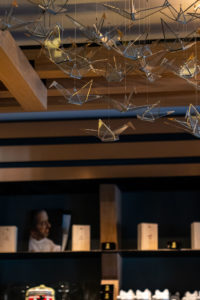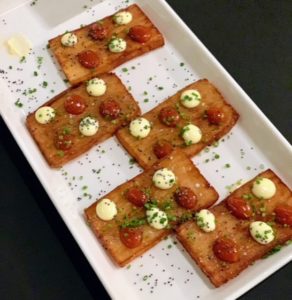Consider the crane. It is a beautiful, long-legged, long-necked bird that carries with it symbolism that varies according to culture. In Japan, the crane or tsuru, is a national treasure. They symbolize longevity, success, and good fortune.
Chef Pepe Moncayo could not have predicted the obstacles he would face when naming the DC restaurant where he deftly fuses Spanish and Japanese techniques and ingredients. But it turns out that Cranes is an apt name for a restaurant that debuted just before the pandemic and is now soaring.
Crane’s path to success would take unflagging perseverance. Buzz was just beginning to build when the pandemic necessitated a closure and then a shift to outdoor dining, carryout, and delivery. It would take months before the restaurant could fully reopen, but soon after Cranes was the recipient of a Michelin star. Those are some dizzying highs and lows.
My initiation to the restaurant is during its first month of operation. The space is impressive with distinct areas that include a sake lounge, bar, and a two-tier dining room. As the fusion concept applies to the menu, it seeps into the décor as well. There are industrial elements that give the space a casual feel, while others swoop in to supply an air of elegance. This includes origami shapes that hang from the ceiling and form the bases of the tables and a flock of glass cranes that hang over the bar. Cranes appear on the tables as well, in the form of chopstick holders.
Moncayo hails from Barcelona, which informs the foundation of his food. The Asian influences are from time spent cooking at Michelin-starred restaurants in Singapore. Moncayo believes there is a similarity between Catalan Spanish cuisine and Japanese cuisine which is about simplicity. He considers his food as a “cultural and culinary marriage.”
There are two paths a meal can take at Cranes. One is an omakase tasting, which puts your meal in the chef’s hands, while the other is to order tapas or à la carte. Either way, the adventure transports you to Spain and Japan, with the dominant influence shifting from dish to dish.
The omakase experience – with an emphasis on seasonal ingredients and artistic plating- is stunning from start to finish. My meal in June includes cherry gazpacho with queso manchego, Spanish mackerel stuffed with shiso, and split pea soup with torched guanciale, micro mint, aged balsamic, and peashoots.
The omakase menu also features smoked duck breast embellished by a ribbon of bok choy which is topped with slivers of mandarinquats for a citrusy jolt. A stream of pepper sauce and a flourish of pureed sunchokes complete the dish.
Crispy-skinned king salmon is glazed with a semi-sweet sauce and served with zucchini rice.
The stellar service, inventive food, and the simple pleasure of not having to belabor over what to order, has me flying high.
Of course there are times when it’s equally enjoyable to wing it at Cranes. A deep dive into the tapas and a la carte menu options reveals dishes with an array of Latin and Asian influences, often with a whimsical twist.
One example- tostada chips as an implement to scoop up creamy eggplant confit topped with fish roe and egg floss.
Another- bao buns as a clever envelope for braised short rib topped with umeboshi mayo and flying fish roe.
Is it even tapas if you don’t have patatas bravas? The potatoes are shaped into rectangles, fried, and accented with dollops of yuzo kosho ketchup and aioli. On one visit to Cranes, my party of four tears into an order and then one more, with absolutely no regrets.
Shrimp tempura is classically Japanese. Aioli, which makes an appearance on numerous dishes here, provides a Catalan accent.
One of my favorites is squid paired with chorizo, sake, rice noodles and puy lentils. At first, it seems an unlikely medley, but the result is a lively confluence of flavors and textures.
The ultimate Japanese/Spanish mashup is unagi paella with smoked eel, snap peas, fresh herbs, jalapeño aioli, and white ponzu sauce. The $33 dish is named one of “The 13 Best Under $35 Dishes D.C. Area Restaurants Served in 2021” by food editor Laura Hayes of Washington City Paper.
The tart and refreshing calamansi cheesecake with lemongrass citrus caviar, calamansi sherbet and pistachio streusel is elegant and immensely satisfying.
It’s notable that this Michelin-starred restaurant is not a break-the-bank experience. The six-course omakase is $98 per person. There is a happy hour menu with some great deals including the patatas bravas ($5), bao bun ($7), and shrimp tempura ($7).
Cranes are known to represent positive change and have been associated with the New Year in various cultures. As we launch into 2022, consider all the uplifting sentiments that cranes convey. And then… consider dining at Cranes.
Cranes, 724 9th Street NW, Washington, DC
















